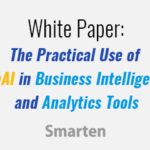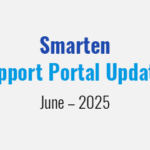
I am going to be blatantly trumpeting of our products, its road map and its usage in this article, and you are likely to get more value out of this than a book on analytics. My guess is that you will read ahead since you are a sceptic.
Let us address what you may be thinking based on the title of this article. It is about bots, AI, machine learning or voice based search. It is about these in some ways, but it is more about your ERP, scores of users in your company, various tools for reporting or analytics and different requirements of data reports and analytics which inundate you.
While our product does much more, these series of articles will focus on small values you can extract out of analytics. Whether you are using a global platform or a customised software solution, Smarten will Smarten your business.
It is also about giving you insights into how this technology works so you get the full picture and it will also get our competitors excited.
So first the top view.
In any business, we look for Facts, problems and solutions. If you are looking for anything which does not get classified in these categories, you need not read further. Our capacity is limited to these three only.
Examples are the primary cause which restricts the scope of imagination, design and applications. I am going to list a few in any case. I urge you to expand these examples into various areas of your life and see how it can be effective. I could have written this in an abstract mode so that you would have hated me for a long time, but since I am up to selling you something, I will skip that.
Let us look at Fact checking:
- We pull a report on receivables, to check the amount due over a certain period
- We push multiple parameters into a form to check the credit limit of a customer
- We will want to know the sales in January last year for a client, and we will put out a sales report for that period from the system
- What is the stock level near expiry, will you pull a report?
- What is the stock of your fastest moving screwdriver in the Bhiwandi warehouse?
- What was the production of our sugar-free chocolate in last Diwali
Good, I hope you do not see the point as I am going to expand on this further while respecting your intelligence. Processing used for fact checking from your ERP or transaction database or CRM is a challenge which the Analytics community has not addressed. The first reason for that is that it does not involve analytics. Analytics has been evolved to drill or filter data. Third and the most important, analytics platform usually do not have data input forms for these types of queries.
A fact finder is also a blame fixer. I would have felt like a management guru if I wrote accountability assessment and source identification instead of “blame fixer”. My favourite example for this question which I have often used in my life: Who ordered that extra stock which gave me two sleepless nights.
In my personal life, I would like my fitness analytics to give more facts and speak them, and I have seen them balancing between analytics and fact reporting.
One of the key space the modern analytics platforms will create is the fact responder or fact list. These will be a list of one to five core facts! This will be the first one to fall into the genre – Kuch Kuch bolta Hain!
The next objective is to look for problems.
Our quest to search for what went wrong is insatiable! The customers who are paying late, the expense which a rotten apple inflates, the stock that is getting too old and so on and so forth.
I have personally never been or ever met a manager who is not looking for problems. The quest for finding problems stems from the need to mitigate a bigger problem or answer a question which was reported as a fact somewhere.
One way you can look for problems is by guesses. Filtering and drill down analytics in dashboards can help in this situation. If one chooses not to invest time in filtering and deep diving, a good idea is to give it to a data scientist and still better ideas is obviously to use our product. And believe you me, we will find the problems.
Let us look at our quest for problems. A problem will stem from a single of various facts. These facts can be a dimension or measure, if I may start using the familiar Business Intelligence terms.
Take the problem as high receivables…. nope, I do not like this issue, it plagues our entire nation, so let us take another issue, reasons for spike in overdue orders in a month.
The answer to this question cannot be a single fact, but a narrative which can be in graphs, tables or can be a paragraph of analysis. The underlining process is typical, and I will describe it here.
Just to emphasise the point, what is getting eliminated in this process is clicking and drilling or graphs, the set hierarchies and the predefined filters.
So, your query in the Clickless world will be, why are such high number of orders overdue in Last month? Will this require sophisticated analytics? And how will this work?
The process of answering queries to identify problems comprises of a few steps other than processing the natural language, and I will try to explain this with simplicity. The first step is determining the dimensions and measures which are around the root, in this case, the root is the “order”. There will be an insight into the data within the group of fields which get associated with an order. This step is common for both problems as well as solution queries.
For identifying the problem, we have to use a regular order book, and some historical data is necessary. Do you need ten years data for this? Just four years ago, I guess, the business was different, the currency was weak, you were younger and the competition weaker! So, for problem identification, three years data at the most will do the trick.
And no, patterns are matched not based on what happened at the same time in the previous year and was this repeated or is similar. The pattern matching past is in the past!
In our world, strewn with simplicity, we form mathematical equations which stand the test of data, recreate that equation to optimise so that we get an equation which proves consistently across a predetermined level of data. If you call optimising equations AI or machine learning, fine, please enjoy calling it that, I will call it optimising equations.
A standard equation must balance on two sides. Numerically. When it does not balance, we have to recycle till we get it right. As simple as that! We all know this, but we are used to fixed equations called business rules as there was no way one could try thousands on the fly due to limited computing power.
Do you want to get insulted with an example? I think some of you would like some guidance with your imagination, so here is a straightforward one.
- Pending orders = Average sales per month + Sales target for the coming month – All in volume, is the first equation that the system will auto generate based on simple data checking depending on what the delivery period is.
- System will show 5 months that are exception to this equation.
- The next dependency is “last month” which should limit the data for last 3 months.
- The customer and products are dependencies of the root order. So, a derivative analysis is customer, per product should balance for the exception months.
At this point, you can get a graph or tabular result for a customer and products where there was a spike which dropped the balance in the equation. The possible introduction of a new customer could be the cause or a spill over due to plant maintenance could have resulted in an inadequate dispatch in a month which is to be still caught up.
A sound system can create multiple equations which can have multiple constants and hold it for validation over multiple variables. This is an elementary example.
A Solution related query is reverse working as done as in the problem. Aha. I am glad you understood this. If you would like to know more, Smarten up. Talk to us. I am writing this with one single intention, to surprise you when you speak to our consultants.
We will continue this in the next article. Please feel free to ask questions. Please use your sense of humour. List your problems.










